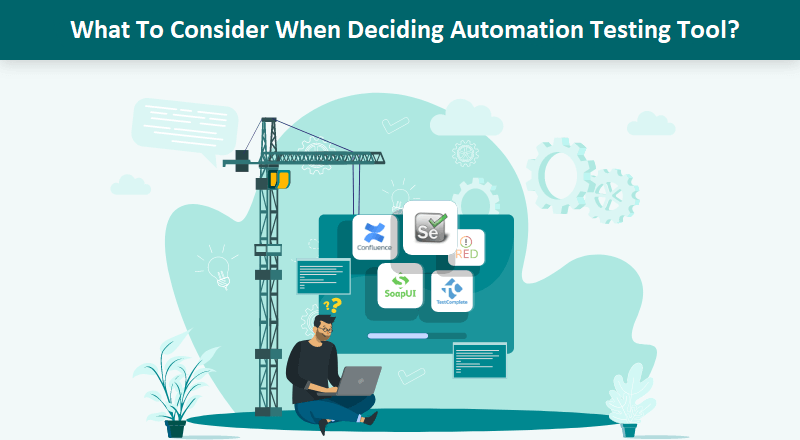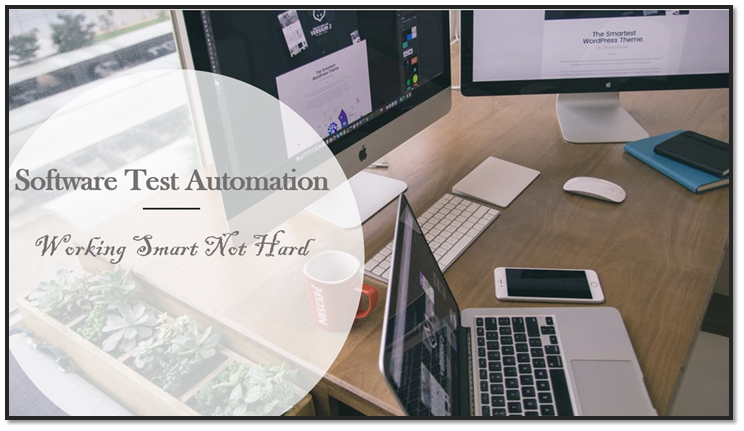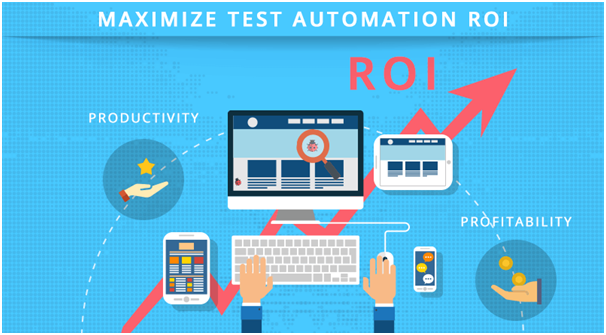“Quality is never an accident; it is always the result of intelligent effort.” – John Ruskin
Software quality was, is, and will always be an integral part of a successful project. Organizations and business owners want things to be fast, good quality, and agile. That is possible only when manual testing is replaced with automation testing and that is driven by an effective automation testing tool.
Automation of testing activities and implementation of relevant testing tools forms the crux of a successful venture. Selecting the right tool is important and can augment the efficacy, quality, precision, and analysis in the right way. The QA team is freed from the burden of manually performing all tests needed for the best of quality.
What is Automation Testing?
Automation Testing aka QA Automation is the procedure of executing tests automatically, performing software testing activities with the least human intervention, and analyzing outputs to enhance software quality. Performing effective test automation offers higher speed, accuracy, and productivity.
QA automation is mainly used for repetitive tasks that need regular and additional testing. It is mainly required for continuous delivery and continuous testing. It includes deciding what test cases are needed, selecting the apt automated testing tool, working upon efforts needed to create the best of data, and creation of automated tests.
The fundamental activity that is crucial for automation testing is deciding upon which tools to choose.
Why Is It Important to Choose the Correct Test Automation Tool?
The main reasons why it is vital to select the apt QA Automation tool are a good tool that assists the software output to be ready for implementation and gets it most close to client expectations. It helps in optimizing resources garnering the best quality output, with the least of human resources.
It overcomes the hurdles faced by testers while doing manual testing. Automated testing tools are key catalysts to drive the implementation of Agile and DevOps practices, leading to effective continuous testing and delivery. Automation tools are known to eliminate hurdles like inability to consider complete testing coverage area, bad user experience, lesser RoI, going back on the competitive edge, increased budget of testing, etc.
Test automation tools showcase benefits like
- Frequent regression and performance testing iterations
- Handling repetitive test cases effectively
- Easy simulation of multiple user cases
- Managing large sets of build verification test cases
- Ensuring complete reliability for all major functionalities
Major Factors to be Considered While Selecting Automation Testing Tools
As important it is to implement test automation tools for effective quality and software testing, it is more significant to choose the right testing tool for your project. Below mentioned factors are important to be considered while doing so:
-
Collaboration and Support
For testers to be supportive to each other and work in harmony is a must. There could be concurrency in work and hence whichever testing tool is chosen, must be able to support sharing of code and scripts, parallel working with data, integration with other systems, etc. The quality of test cases, their output files, etc. must be easily accessible since the client may want to view them.
Easy and seamless integration of the testing tools with the system with other stakeholders or with other external systems is a must. This makes the management and maintenance of testing cycles easy and lucid. There must be easy integration with continuous delivery and continuous integration tools if any.
-
Testing Team Skills
The major point of concern and care is the team that is going to implement the automated testing tools. Project managers and stakeholders must take into consideration the skill level of the testing team and then decide the tool accordingly. Yes, a new QA Automation Engineer may be hired, if needed but overall, it is better to either train your own testers for the same or maybe, hire a few new ones.
It must be ascertained right from start what level of expertise do the testers possess and how well does it match with the prospective testing tools. Whatsoever testing tool you choose, it may be codeless or may need coding. The team members must possess the necessary skills in the programming language involved. Even the level of writing test cases and preparing test data must be analyzed right from start.
-
Robust and Feature Rich Tool
As requirements increase and technology expands, the software applications are sure to get enhanced and complex. The automated testing tool must be selected keeping in mind a futuristic view of the implementation cycle. The tool must be capable enough to support all upcoming changes and modifications with uninterrupted implementation and complete user satisfaction.
The testing tool must be competent to face any type of hurdles that come along, be it any project development life cycle – waterfall, agile, DevOps, etc. Project owners would need futuristic eyesight to realize what sort of issues could come up soon and how much would the software application expand its horizons. The chosen tool should be able to gel well with all databases and functionalities in the system.
-
Change and Result Management
There is no software application that does not undergo changes with time and with user demands. These changes may bring out alterations in the user interface and user design of the application. The testing tool that you choose must be capable to understand these changes and embed the new test cases and situations in the testing cycle, without any disturbance.
The outputs of the testing processes like logs, dashboards, etc. are a must to be viewed and analyzed. The testing tool must be able to present these artifacts in a manageable manner so that testers and developers find it easy to extract the desired information. The testing procedure must be made smooth and authentic by the testing tool.
-
Scalability of Tests
Depending upon the size and scope of the system, the number, and variety of test cases may be scaled up and down, frequently. The chosen automated tool must be scalable enough to incorporate the increase and decrease of tests, with no hindrance to the main working cycle.
Testing could include a wide variety like performance testing, functional testing, load testing, etc. The system and the tool must be scalable to embed the range of testing activities in its working style. Tight integration with different plug-ins or add-ons may also be required in case they are used.
-
Platform and OS Compatibility
There are multiple platforms and OS being used today and there are chances of them occurring in a single software application. Whatever testing tool is chosen, must be able to gel seamlessly with all these platforms and operating systems. The higher the compatibility of the tool with different hardware infrastructure, the better are the chances of good performance and cost-effective functioning.
A futuristic view is also needed for the same. There are chances that some of the OS or hardware are not being used right now but may be used or needed in the future. The testing tool must be able to encompass the possibilities and be friendly to those options too. Only then can the entire software application function without any problem. Even a smooth functioning with the older versions is a must.
-
Easy Creation and Maintenance of Test Scripts
Test scripts form the base of an effective and fast testing forum. Especially when it is an automated version, the generation of test scripts is a must for testing teams to effectively observe all possible combinations of testing data. The tool must be compliant with all libraries, plug-ins, etc for writing test cases easily. It must be able to handle all different situations and offer the best testing outputs.
Generation of test cases is also important and hence the tool must be chosen in such a way that it is able to create test cases and test scripts on its own, taking into consideration all possible functionalities that are a part of the system. The cost-effectiveness is bound to increase with proper utilization of the tool in the creation of test scripts.
-
Easy Reporting and Maintenance Procedure
However effective the testing process is, if there is a fault in the reporting and maintenance process, the testing team will find it very difficult to garner the actual result outputs. Hence, the tool must be chosen in such a way that it is able to generate logs and dashboards that report all the outputs in the best possible manner, and it is easy to maintain them.
Modular test cases must be generated and executed for better management of testing scenarios. Failure logs must be provided in detail for better fixation and easy maintenance. Only then the automation will bring in the desired profitability, success, and a peep into the possible future outcomes.
-
Budget and Pricing
Whatever tool it is, one important aspect while selecting it is the price of the tool and the budget allocation to purchasing and maintaining that tool. There are a variety of tools that are open-source which are not that costly and licensed which do have a cost attached. Based on the organizational budget allocated, you must choose the desired tool.
While watching the costing figures, it must be taken into consideration as to what other add-ons and associated costs may crop up in the future. That will surely add to the costs and hence must be verified beforehand itself. Even while working on the budget, things like resource costs, learning curve, time to be spent while automating, infrastructure cost, etc. must be analyzed and detailed upon.
-
Project Needs and Future Plans
It is useless to decide on a testing tool if you are not aware of what the project is all about and what are its future activities. Hence, before finding out the right too, it is important to understand the project statement, its implementation guidelines, the future course of action, etc.
Testers must be aware of the type of application that is to be tested, the platform on which it is being built, the programming language it is using, infrastructure/device/hardware dependencies, operating systems involved, etc.
Some Questions That Must Be Answered
- Do you have the requisite resources and skills needed to implement the automated testing tool?
- Is there a specified budget allocated to the purchase of the tool and its related plug-ins etc.?
- Does the tool fulfill all your project requirements?
- Do you need the tool only specific to this project or will it be useful for further projects to come?
- Is the latest version released recently? Does it have all features that are required?
- Is the tool capable of creating and maintaining test scripts and test cases?
- Are proper logs and dashboards generated for better analysis?
- Is the user interface simple and effective for novices to learn?
- Is the vendor established enough to offer the best of services?
- Are all testers getting enough training?
- Are there only good reviews for the tool online or are there critical ones too?
- What is the actual price of the automated testing tool?
- Does the tool offer support for the hardware/OS/browsers/infrastructure in which the software application executes?
- Does the tool offer support for the technologies and third-party components used in the software application?
- How many programming languages does this tool support? Are there sufficient resources for the same?
- Is the tool seamlessly compatible with other data sources and data components?
- Does the reporting mechanism of the tool offer good analytical outputs?
- How is the technical support system offered by the vendor?
On a Parting Note
Organizations worldwide are using popular Automated Software Testing tools like Selenium, SoapUI, Katalon Studio, JMeter, Appium, Cucumber, Robot Framework, and many more. Each of these testing tools have their own characteristic and based on the key considerations discussed above, businesses must finalize which one to choose from.
Though a tough call, selecting the most preferred testing tool is a key component in the success story of any project. And considering the above major factors can surely help in selecting the best-suited one!






